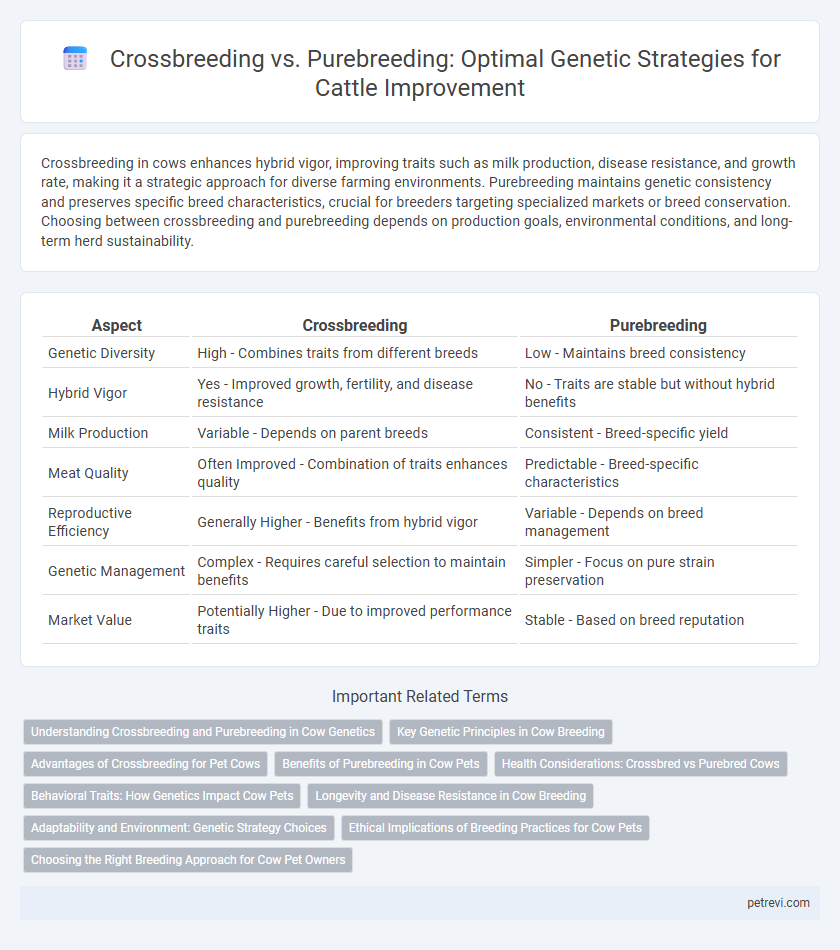Crossbreeding in cows enhances hybrid vigor, improving traits such as milk production, disease resistance, and growth rate, making it a strategic approach for diverse farming environments. Purebreeding maintains genetic consistency and preserves specific breed characteristics, crucial for breeders targeting specialized markets or breed conservation. Choosing between crossbreeding and purebreeding depends on production goals, environmental conditions, and long-term herd sustainability.
Table of Comparison
| Aspect | Crossbreeding | Purebreeding |
|---|---|---|
| Genetic Diversity | High - Combines traits from different breeds | Low - Maintains breed consistency |
| Hybrid Vigor | Yes - Improved growth, fertility, and disease resistance | No - Traits are stable but without hybrid benefits |
| Milk Production | Variable - Depends on parent breeds | Consistent - Breed-specific yield |
| Meat Quality | Often Improved - Combination of traits enhances quality | Predictable - Breed-specific characteristics |
| Reproductive Efficiency | Generally Higher - Benefits from hybrid vigor | Variable - Depends on breed management |
| Genetic Management | Complex - Requires careful selection to maintain benefits | Simpler - Focus on pure strain preservation |
| Market Value | Potentially Higher - Due to improved performance traits | Stable - Based on breed reputation |
Understanding Crossbreeding and Purebreeding in Cow Genetics
Crossbreeding in cows combines genetic traits from different breeds to enhance hybrid vigor, improving growth rates, fertility, and disease resistance. Purebreeding maintains genetic consistency within a breed, preserving specific traits such as milk yield or meat quality but may increase susceptibility to inherited disorders. Selecting between crossbreeding and purebreeding depends on production goals, environmental conditions, and the desired balance between genetic diversity and trait uniformity.
Key Genetic Principles in Cow Breeding
Crossbreeding in cows leverages heterosis or hybrid vigor, enhancing traits such as fertility, growth rate, and disease resistance by combining diverse genetic lines. Purebreeding maintains genetic consistency and predictability by preserving specific breed characteristics but can increase the risk of inbreeding depression and associated genetic disorders. Effective cow genetic strategies balance these principles to optimize productivity, health, and adaptability in diverse environmental conditions.
Advantages of Crossbreeding for Pet Cows
Crossbreeding pet cows enhances genetic diversity, leading to improved health traits and greater resistance to diseases compared to purebred lines. The hybrid vigor from crossbreeding often results in better adaptability to various environments and increased lifespan, which is essential for pets. This genetic strategy also promotes a diverse genetic pool, reducing the risk of inherited disorders common in purebred cows.
Benefits of Purebreeding in Cow Pets
Purebreeding in cow pets ensures genetic consistency, resulting in predictable traits such as temperament, size, and milk production capacity. Maintaining a purebred lineage enhances breed-specific health advantages and reduces the risk of genetic disorders common in mixed breeds. Owners benefit from the reliability in behavior and physical characteristics, which supports better management and personalized care.
Health Considerations: Crossbred vs Purebred Cows
Crossbred cows often exhibit hybrid vigor, resulting in enhanced immune responses and lower susceptibility to diseases compared to purebred cows, which may suffer from inbreeding depression and related health issues. Purebred cows maintain genetic uniformity that can facilitate predictability in traits but often at the expense of reduced genetic diversity, leading to increased vulnerability to specific pathogens. Prioritizing crossbreeding in genetic strategies can improve herd resilience by combining favorable traits from multiple breeds, thereby enhancing overall health and productivity.
Behavioral Traits: How Genetics Impact Cow Pets
Crossbreeding in cows often enhances behavioral traits such as temperament and sociability, resulting in more docile and adaptable pets compared to purebred cows, which may exhibit more consistent but sometimes less flexible behaviors. Genetic diversity from crossbreeding can reduce stress responses and improve human-animal interactions, making crossbred cows preferable for families or small farms focused on cow companionship. Purebreeding maintains predictable traits but may increase the risk of inherited behavioral issues, emphasizing the importance of selecting breeding strategies aligned with pet management goals.
Longevity and Disease Resistance in Cow Breeding
Crossbreeding in cow genetic strategy enhances longevity and disease resistance by combining diverse gene pools, resulting in hybrid vigor that improves overall herd health. Purebreeding focuses on preserving specific traits, but often limits genetic diversity, which can reduce resilience against diseases and shorten lifespan. Balancing both methods strategically maximizes cow productivity and sustainability in breeding programs.
Adaptability and Environment: Genetic Strategy Choices
Crossbreeding enhances cattle adaptability by combining diverse genetics, improving resistance to local diseases and environmental stresses compared to purebreeding. Purebreeding maintains uniform traits but may limit genetic variation necessary for adapting to changing climates and diverse farming conditions. Selecting genetic strategies requires balancing environmental resilience with production goals to optimize herd performance.
Ethical Implications of Breeding Practices for Cow Pets
Crossbreeding in cows enhances genetic diversity, reducing inherited diseases and improving overall health, which aligns with ethical standards promoting animal welfare for pet cows. Purebreeding, while preserving specific breed traits, risks increasing susceptibility to genetic disorders, raising concerns about long-term health and quality of life. Ethical breeding practices prioritize the well-being and natural behavior of cow pets, ensuring that genetic strategies do not compromise their health or lead to unnecessary suffering.
Choosing the Right Breeding Approach for Cow Pet Owners
Crossbreeding in cows enhances genetic diversity, often resulting in hybrid vigor, improved health, and higher productivity, making it ideal for pet owners seeking robust and adaptable animals. Purebreeding preserves specific desirable traits and pedigree lines, ensuring consistency in appearance and behavior, which benefits owners focused on breed standards. Selecting the right breeding approach requires assessing goals such as genetic health, performance, and temperament to align with the unique needs of cow pet ownership.
Crossbreeding vs Purebreeding for Cow Genetic Strategy Infographic

 petrevi.com
petrevi.com